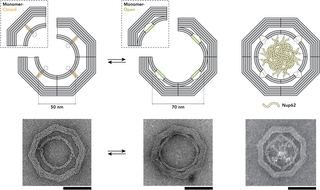A tetrameric dynamic DNA nano-ring for evaluating the collective interaction of FG-Nups. Schematics and negative-stain electron micrographs of the dynamic DNA nano-ring show that the inner ring diameter changes in response to DNA oligonucleotides (orange and green) that rigidify specific regions of the scaffold strand (left) or FG-Nups (yellow) that cluster in the middle of the ring. Scale bars: 50 nm.

Eason Cao ‘26
(he/him)
Home Department: Cell Biology (C. Lin Lab)
Research Project: Modeling the collective behavior of FG-Nups in the nuclear pore complex by dynamic DNA nanopores
At the center of the nuclear pore complex (NPC), hundreds of intrinsically disordered phenylalanine-glycine (FG)-rich nucleoporins (Nups) interact transiently with each other and binding partners, such as nuclear transport receptors (NTRs), to perform the vital function as the gatekeepers of the nucleus. Decades of research has depicted a general principle of how FG-Nups form a selective filter but leave many mechanistic questions unanswered due to the complexity of the nucleocytoplasmic transport machinery. Here, we build dynamic NPC mimics to quantify the interaction of nanopore-confined FG-Nups. Specifically, the expandable DNA origami-based nanopore changes its diameter in response to various Nup-Nup and Nup-NTR interactions, providing an innovative tool to measure the strengths of these molecular interactions in an NPC-like environment and elucidate the impact of NPC expansion/constriction on the nucleocytoplasmic transport.
Relevant Publications
